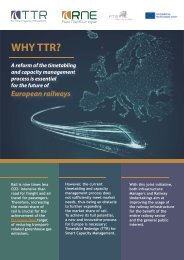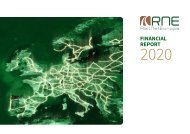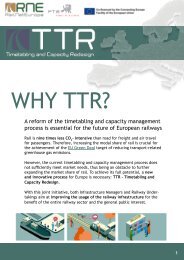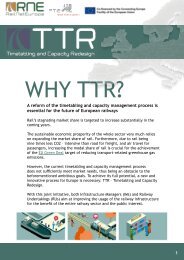TTR_Extended_Brochure_final_UPDATE_FEB
You also want an ePaper? Increase the reach of your titles
YUMPU automatically turns print PDFs into web optimized ePapers that Google loves.
IT LANDSCAPE<br />
COMMERCIAL<br />
The goal of implementing a revised process and achieving efficient<br />
communication at European level among all stakeholders can only be<br />
reached through synchronised digitalisation and the joint usage of<br />
dedicated IT systems that are specifically designed and customised to the<br />
<strong>TTR</strong> process.<br />
The <strong>TTR</strong> IT landscape aims to<br />
• increase the quality of information exchanged between all stakeholders,<br />
• accelerate process steps by allowing for a certain extent of automation,<br />
• provide easy access to all stakeholders, either via interfaces or via web<br />
browsers.<br />
The IT Landscape consists of two main blocks: the central IT framework<br />
developed by RNE and national and external systems, which will<br />
communicate with the central IT framework. The communication will be<br />
based on TAF/TAP TSI standards.<br />
Several important functions for RUs (Capacity Needs Announcements,<br />
Train Harmonisation, Path Request Management) and IMs (TCRs, Capacity<br />
Hub, Capacity Broker, Path Management) will be combined in one single<br />
environment.<br />
CONDITIONS<br />
To encourage stakeholders to use<br />
the process and capacity products<br />
as efficiently as possible, certain<br />
commercial conditions must be agreed<br />
and applied to avoid loss of capacity and<br />
ensure consistency across borders at<br />
European level.<br />
Rail capacity is wasted, mainly due to<br />
• capacity blocked but eventually not<br />
used by RU stakeholders<br />
• constantly changing planning<br />
parameters (both RU and IM)<br />
Commercial Conditions shall steer the<br />
behaviour of stakeholders towards making the best use of available<br />
capacity on the rail network.<br />
The following process elements require steering through commercial<br />
conditions:<br />
• Path modification, cancellation and non-usage by Applicant due to<br />
commercial or operational needs<br />
• Path alteration and cancellation by IM in connection with TCRs (late<br />
TCRs, changes in planned TCRs)<br />
Commercial Conditions are part of the focused projects to find consensus<br />
among IMs and RUs.<br />
6<br />
7








